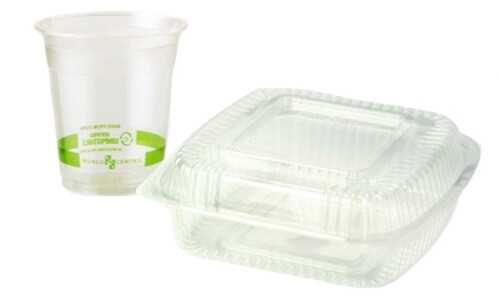Compostables are Eco-Friendly… Right?

Compostable plates and utensils may seem like they’re good for the planet, but let us take you through a few reasons as to why science shows us that they’re not the most viable solution.
1. They’re Still Single-Use
It’s often a misconception that compostable food serviceware eliminates single-use waste in our landfills and ecosystems. After all, they are made from natural materials meant to break down in the environment. However, a study conducted by Upstream, a leading NGO in reuse space, finds that compostables are responsible for a heavy amount of waste and contamination, as most of it isn’t converted into reusable matter, such as the fertilizer and soil you may use in your garden.
Here’s why. The molecular construction of these materials hinders them from decomposing on their own, but must instead be processed by industrial facilities. This is because most compostable items used in food serviceware consist of a material called bioplastic. Rather than being composed of synthetic chemicals, bioplastics are derived from vegetable matter such as corn starch or woodchips. While they may be natural, these materials are bonded in such a way that intense heat is needed to break them down. That’s why most compost facilities opt to forego on degrading bioplastics – the heat kills the beneficial microbes and other microorganisms found in other non-manufactured compost components. This exclusion of bioplastics, therefore, creates copious amounts of waste, as the food serviceware is sent to landfills instead.
Furthermore, most facilities don’t accept compostables as they don’t add any valuable nutrients to the compost. Typical organic matter such as food scraps or plant clippings contains valuable amounts of nitrogen, a nutrient that speeds the decomposition process. Since compostables are manufactured products, they are virtually devoid of these helpful nutrients, which adds to the list of reasons why compost facilities are reluctant to take them in.
A study that involved almost 200 composting facilities in the United States found that less than half of them accept compostable food serviceware. These rejected materials are instead passed on to landfills where they are left to sit for decades at a time. To make matters worse, a study from Columbia University’s Climate School finds that the deprivation of oxygen in landfills may cause the compostables to release methane - a harmful greenhouse gas, which can be around 28-80 times more potent than carbon dioxide in breaking down our atmosphere’s ozone.
Dangers of PLA Products

Recognize these at restaurants and cafes? This type of serviceware is made from Polylactic Acid (PLA) and are some of the most insidious things to the environment. This is because they are biodegradable; while this may sound like a good thing, they aren’t completely made of organic material and can release microplastics. This misleading designation promotes a greenwashing mentality that most consumers find themselves victim to: ”since it is labeled as biodegradable, it must be good for the environment and alright to toss wherever since it’ll just decompose anyway.” Sadly, this mindset has contributed to the continuation of single-use habits, as most PLA serviceware is mindlessly thrown in with true organic matter such as food or plant waste, which thus contaminates them. Just one piece of this bioplastic can take up to 100-1000 years to naturally decompose in a landfill.
2. Extensive Fossil Fuel Use and GHG Emissions
Compostables are produced with agriculturally derived feedstock (e.g. sugarcane, corn, potatoes) that require extensive use of fossil fuels. Fertilizers and pesticides are used to grow the crops that make up compostables, and chemical processes are employed to convert them to food serviceware – all of which emit harmful greenhouse gases that deplete our earth’s ozone. Nevertheless, emissions remain a problem throughout the whole lifecycle of a compostable.
Emissions begin as early as production – since a majority of compostable serviceware is manufactured overseas, GHGs happen to be released during the transportation process. A statistical analysis conducted in 2021 found that over 50% of compostables and biodegradables are produced in Asia. Having these materials shipped back and forth across oceans and countries via plane or cargo ship only to be used for a few minutes is far from eco-friendly.
But alarmingly enough, the emissions don’t stop there. A study conducted in 2020 by Washington State University found that the decomposition process of compostables is responsible for releasing a variety of harmful fumes that accelerate climate change, ranging from greenhouse gases (GHGs) to volatile organic compounds (VOCs) — all of which are harmful to both the environment and to human health.
To start off with GHGs, the most common one released by compostable serviceware is carbon dioxide, a damaging heat-trapping gas. While carbon dioxide is already abundant in the atmosphere, excess amounts of it being released by compostables accelerates the rising temperature of our planet. As for VOCs – these gases are some of the worst known enemies to climate activists across the globe, as they are considered the most effective fumes when it comes to speeding climate change. Many of them contain chlorofluorocarbons, compounds that rapidly break down the Earth’s protective ozone. Furthermore, a study conducted by the Minnesota Pollution Control Agency found that some VOCs, such as benzene, are carcinogenic in nature, and can lead to cancer or health issues, such as gradual organ failure in humans.
Compostable products may seem earth-friendly, but the reality is that they produce more GHGs across their life cycles, during their production and break-down phases, than other forms of eco-friendly serviceware. By switching to reusable foodware, consumers are able to avoid billions of tons of emissions that are released every year by single-use products that are labeled “good for the environment.”
 Cornstarch makes up around 65% of all compostable and biodegradable materials.
Cornstarch makes up around 65% of all compostable and biodegradable materials.
3. Hazardous for Human Health
Aside from creating waste and greenhouse gas emissions, compostables pose another danger – one that could last forever. To allow take-out containers to hold wet or greasy food, compostable food serviceware is often treated with polyfluoroalkyl chemicals (PFAS). According to the Center for Disease Control (CDC), the worst of PFAS are linked to serious health outcomes, such as kidney and testicular cancer.
PFAS are notoriously labeled as “forever chemicals” by researchers, as they have been designed to resist decomposition in both laboratory and natural settings. To make matters worse, there are no known means of eliminating them. With the adoption of compostable materials in serviceware only becoming more prevalent around the globe, the amount of PFAS polluting the environment is going to continue increasing.
As if it couldn’t be any drearier, the mass accumulation of such chemicals has led to them leaching into our waterways. Conservatively, scientists estimate that PFAS leakage taints the drinking water of over 200 million Americans. Furthermore, this contaminated water has been finding its way into our agricultural infrastructure and farmlands, where it pollutes our crops and livestock. A toxicologist in Michigan revealed that even some dairy cows have been found to have PFAS in their bodies, meaning that the chemicals could potentially be found in the milk on our shelves. Without governmental limitations being placed on the materials used to create compostables and other food serviceware, continued use of them will only further damage the future of our environment and our health.
 Although this bowl looks innocent enough, this compostable take-out container may contain enough PFAS to contaminate the earth and its crops for generations to come.
Although this bowl looks innocent enough, this compostable take-out container may contain enough PFAS to contaminate the earth and its crops for generations to come.
Where FoodWare Is Stepping In
Sustainability has to be backed by science, which is why it is crucial to focus on reusables as the future of foodware. By introducing an innovative collect and return system, we are taking strides to eliminate waste and greenhouse gas emissions across the food industry. After all, the problem doesn’t just lie in the single-use takeout packaging, it lies in the single-use itself.